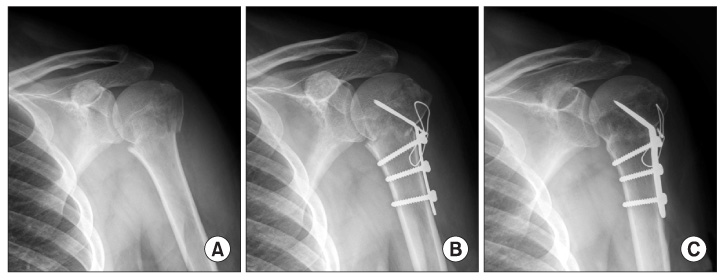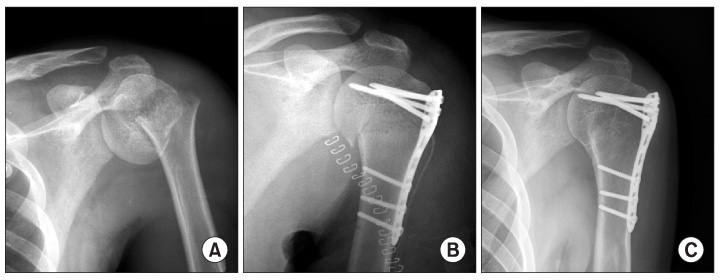J Korean Orthop Assoc.
2011 Oct;46(5):372-379.
A Comparative Study of Three Different Fixation Techniques for Displaced Two- and Three-Part Proximal Humeral Fractures
- Affiliations
-
- 1Department of Orthopedic Surgery, Pusan National University School of Medicine, Busan, Korea. scheon@pusan.ac.kr
Abstract
- PURPOSE
To analyze and compare the results of three different surgical methods - closed reduction and percutaneous pinning (Group I), bifurcated plate and tension band wiring (Group II), locking compression plate (Group III), - for displaced two- and three-part proximal humeral fractures.
MATERIALS AND METHODS
Sixteen patients were treated with a closed reduction and percutaneous pinning, 19 with bifurcated plate and tension band wiring and 18 with locking compression plate. All patients were followed up for more than 1 year, and were reviewed and evaluated with respect to radiological and clinical results. The radiological results were evaluated by bony union and humerus neck shaft angle using the Paavolainen method. The clinical results were evaluated by Neer's evaluation criteria.
RESULTS
Bony union rate, time period to achieve bony union, neck shaft angle and clinical results in Groups II and III were better than those in Group I (p<0.05). There were no significant differences between Groups II and III. We observed trends for worse clinical outcomes in patients older than 65 years compared with those in patients younger than 65 years. Clinical outcome for patients older than 65 years in Group III (average 87.5 points) was better than that for the same age group in Groups I (average 77.2 points) and II (average 79.3 points), but the cohorts were too small to obtain statistical significance. Complication rate in Groups II, III was lower than that in Group I (p=0.005).
CONCLUSION
The radiological and clinical results in Groups II and III were significantly better than those in Group I, and there were no significant differences between Groups II and III. We thought that bifurcated plate and tension band wiring and locking compression plate were useful surgical methods for displaced two- and three-part proximal humeral fractures.
Keyword
Figure
Reference
-
1. Jaberg H, Warner JJ, Jakob RP. Percutaneous stabilization of unstable fractures of the humerus. J Bone Joint Surg Am. 1992. 74:508–515.
Article2. Flatow EL, Cuomo F, Maday MG, Miller SR, McIlveen SJ, Bigliani LU. Open reduction and internal fixation of two-part displaced fractures of the greater tuberosity of the proximal part of the humerus. J Bone Joint Surg Am. 1991. 73:1213–1218.
Article3. Adedapo AO, Ikpeme JO. The results of internal fixation of three- and four-part proximal humeral fractures with the Polarus nail. Injury. 2001. 32:115–121.
Article4. Esser RD. Treatment of three- and four-part fractures of the proximal humerus with a modified cloverleaf plate. J Orthop Trauma. 1994. 8:15–22.
Article5. Tanner MW, Cofield RH. Prosthetic arthroplasty for fractures and fracture-dislocations of the proximal humerus. Clin Orthop Relat Res. 1983. 179:116–128.
Article6. Wijgman AJ, Roolker W, Patt TW, Raaymakers EL, Marti RK. Open reduction and internal fixation of three and four-part fractures of the proximal part of the humerus. J Bone Joint Surg Am. 2002. 84:1919–1925.7. Lill H, Hepp P, Korner J, et al. Proximal humeral fractures: how stiff should an implant be? A comparative mechanical study with new implants in human specimens. Arch Orthop Trauma Surg. 2003. 123:74–81.8. Kristiansen B, Christensen SW. Plate fixation of proximal humeral fractures. Acta Orthop Scand. 1986. 57:320–323.
Article9. Paavolainen P, Björkenheim JM, Slätis P, Paukku P. Operative treatment of severe proximal humeral fractures. Acta Orthop Scand. 1983. 54:374–379.
Article10. Björkenheim JM, Pajarinen J, Savolainen V. Internal fixation of proximal humeral fractures with a locking compression plate: a retrospective evaluation of 72 patients followed for a minimum of 1 year. Acta Orthop Scand. 2004. 75:741–745.11. Fankhauser F, Boldin C, Schippinger G, Haunschmid C, Szyszkowitz R. A new locking plate for unstable fractures of the proximal humerus. Clin Orthop Relat Res. 2005. 430:176–181.
Article12. Rowles DJ, McGrory JE. Percutaneous pinning of the proximal part of the humerus. An anatomic study. J Bone Joint Surg Am. 2001. 83:1695–1699.13. Neer CS II. Displaced proximal humeral fractures. I. Classification and evaluation. J Bone Joint Surg Am. 1970. 52:1077–1089.14. Neer CS 2nd. Displaced proximal humeral fractures. II. Treatment of three-part and four-part displacement. J Bone Joint Surg Am. 1970. 52:1090–1103.15. Stableforth PG. Four-part fractures of the neck of the humerus. J Bone Joint Surg Br. 1984. 66:104–108.
Article16. Moda SK, Chadha NS, Sangwan SS, Khurana DK, Dahiya AS, Siwach RC. Open reduction and fixation of proximal humeral fractures and fracture-dislocations. J Bone Joint Surg Br. 1990. 72:1050–1052.
Article17. Kolodziej P, Lee FS, Patel A, et al. Biomechanical evaluation of the schuhli nut. Clin Orthop Relat Res. 1998. 347:79–85.
Article18. Sehr JR, Szabo RM. Semitubular blade plate for fixation in the proximal humerus. J Orthop Trauma. 1988. 2:327–332.
Article19. Duralde XA, Leddy LR. The results of ORIF of displaced unstable proximal humeral fractures using a locking plate. J Shoulder Elbow Surg. 2010. 19:480–488.
Article20. Chung ST, Kim HC, Yoo JH, Cho YJ. Treatment of proximal humeral fractures using modified steinmann pins and tension band wiring. J Korean Orthop Assoc. 2004. 39:69–74.
Article21. Tamai K, Ohno W, Takemura M, Mashitori H, Hamada J, Saotome K. Treatment of proximal humeral fractures with a new intramedullary nail. J Orthop Sci. 2005. 10:180–186.
Article22. Tae SK, Jung YB, Song KS. The result of operative treatment in fracture of the proximal humerus. J Korean Orthop Assoc. 1999. 34:789–795.
Article23. Chen CY, Chao EK, Tu YK, Ueng SW, Shih CH. Closed management and percutaneous fixation of unstable proximal humerus fractures. J Trauma. 1998. 45:1039–1045.
Article24. Martin DP, Engelberg R, Agel J, Swiontkowski MF. Comparison of the Musculoskeletal Function Assessment questionnaire with the Short Form-36, the Western Ontario and McMaster Universities Osteoarthritis Index, and the Sickness Impact Profile health-status measures. J Bone Joint Surg Am. 1997. 79:1323–1335.
Article25. Sallay PI, Reed L. The measurement of normative American Shoulder and Elbow surgeons scores. J Shoulder Elbow Surg. 2003. 12:622–627.
Article
- Full Text Links
- Actions
-
Cited
- CITED
-
- Close
- Share
- Similar articles
-
- Conservative Treatment of Proximal Humeral Fracture
- Percutaneous Pinning & External Fixation In the Treatment of Proximal Humerus Fracture
- Clinical Observation on Displaced Proximal Humeral Fracture
- The Proximal Humeral Fractures Treated by the Primary Prosthetic Replacement: A Report of 3 Cases
- Clinical Observation on Displaced Proximal Humeral fracture




